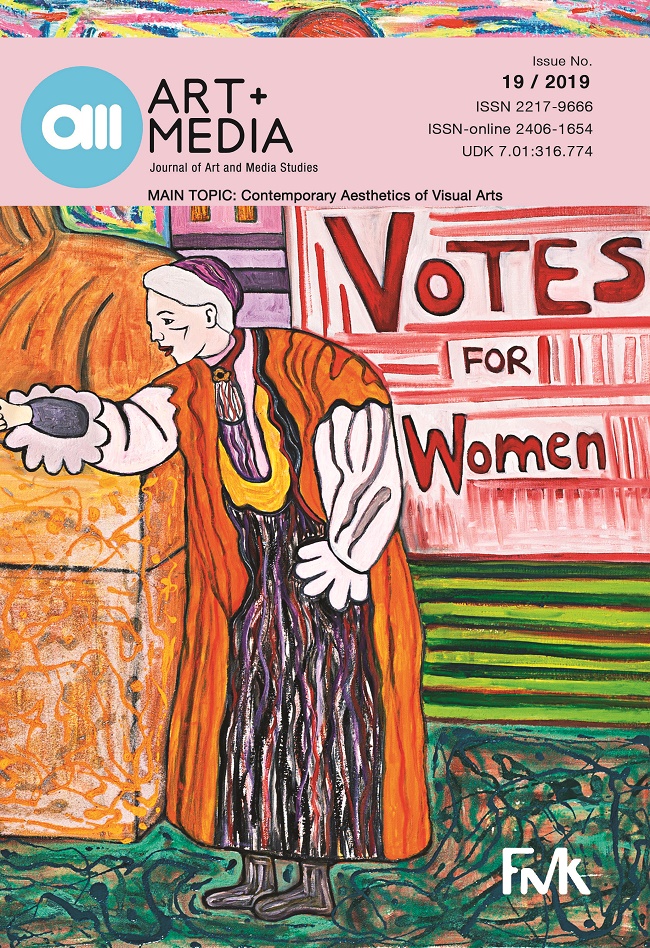Zlatko Paković's Vox Dei – Civil Disobedience as an Embodied Text: The Impact of Different Types of Spaciality on Semioticity of a Performance
DOI:
https://doi.org/10.25038/am.v0i19.317Keywords:
corporeality, bodily co-presence, performance, political theater, spatiality, Vox Dei – Civil Disobedience, Zlatko PakovićAbstract
This paper deals with the corporeality of a performance and its place in the process of the emergence of meaning, following a case study of a Serbian theatrical piece Vox Dei – Civil Disobedience. Performance is constituted by bodies brought together by a certain purpose and temporal and spatial coordinates, and it is more and more often now decoded by the feedback loop performers and participants form in specific kinds of spatiality. Artistic corporeality defies objectivization, therefore the relational aesthetics is needed instead of an idealistic one to investigate the materiality of these performances. Using this theoretical framework, the analysis of the two different performances of the same dramatic text from the recent Serbian political theater production will tend to examine the nature of political potential of bodily co-presence in artistically and socially different environments and its implications for the semioticity of the given embodied text.
Article received: April 5. 2019; Article accepted: June 10, 2019; Published online: September 2019; Original scholarly paper
References
Altiser, Luj. Ideologija i državni ideološki aparati. Beograd: Karpos, 2009.
Butler, Judith. Gender Trouble. New York, London: Routledge, 1990.
Fischer-Lichte, Erika. The Routledge Introduction to Theatre and Performance Studies. London, New York: Routledge, 2014. DOI: https://doi.org/10.4324/9780203068731
Fischer-Lichte, Erika, The Transformative Power of Performance. London, New York: Routledge, 2008. DOI: https://doi.org/10.4324/9780203894989
Fisher Lichte, Erika. “Interweaving Cultures in Performance: Different States of Being in Between.” TEXTURES, August 2010.
Ilić, Vlatko, Irena Ristić. “Dialogue on Performative Turns: From a Theater Autonomy to the Repeal.” In Theater within a Context… And not Just Theater, ed. Vlatko Ilić, Irena Ristić, 10–29. Belgrade: Hop.La! and Faculty of Dramatic Arts, 2016.
Jovićević, Aleksandra, Ana Vujanović. Uvod u studije performansa. Beograd: Fabrika knjiga, 2006.
Milohnić, Aldo. Teorija savremenog teatra i performansa. Belgrade: Orion Art, 2013.
Paković, Zlatko. “Vox dei – Civil disobedience.” Danas, 30th April – 2nd May Issue, 2019.
Reinelt Janell, Politics and Performing Arts. Belgrade: University of Arts, 2012.
Scheckner, Richard. Performance Theory. New York, London: Routledge, 2005.
Šuvaković, Miodrag. Epistemologija umetnosti. Kritični dizajn za procedure i platforme savremenog umetničkog obrazovanja. Beograd: Orion Art, 2007.
DOI: http://dx.doi.org/10.25038/am.v0i19.317 DOI: https://doi.org/10.25038/am.v0i19.317
Downloads
Published
How to Cite
Issue
Section
License
Copyright (c) 2023 AM Journal of Art and Media Studies

This work is licensed under a Creative Commons Attribution 4.0 International License.
The content on this site is licensed under a Creative Commons Attribution 4.0 International License.
AM Journal of Art and Media Studies ISSN 2217-9666 - printed, ISSN 2406-1654 - online, UDK 7.01:316.774
Contact: amjournal@outlook.com
Publisher: Faculty of Media and Communications, Singidunum University, Belgrade, Serbia
Indexed in: ERIH PLUS, EBSCO, DOAJ, and in The List of Scientific Journals Categorization of Ministry of Education, Science and Technological Development of Republic of Serbia (M24 in 2021; M23 in 2023). Beginning with No. 12 2017, AM is indexed, abstracted and covered in Clarivate Analytics service ESCI.

